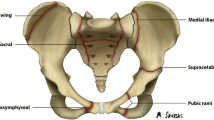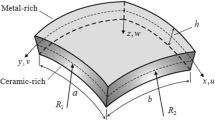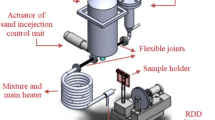Abstract
For traumatic lumbar spine injuries, the mechanisms and influence of anthropometrical variation are not yet fully understood under dynamic loading. Our objective was to evaluate whether geometrically subject-specific explicit finite element (FE) lumbar spine models based on state-of-the-art clinical CT data combined with general material properties from the literature could replicate the experimental responses and the fracture locations via a dynamic drop tower-test setup. The experimental CT datasets from a dynamic drop tower-test setup were used to create anatomical details of four lumbar spine models (T12 to L5). The soft tissues from THUMS v4.1 were integrated by morphing. Each model was simulated with the corresponding loading and boundary conditions from the dynamic lumbar spine tests that produced differing injuries and injury locations. The simulations resulted in force, moment, and kinematic responses that effectively matched the experimental data. The pressure distribution within the models was used to compare the fracture occurrence and location. The spinal levels that sustained vertebral body fracture in the experiment showed higher simulation pressure values in the anterior elements than those in the levels that did not fracture in the reference experiments. Similarly, the spinal levels that sustained posterior element fracture in the experiments showed higher simulation pressure values in the vertebral posterior structures compared to those in the levels that did not sustain fracture. Our study showed that the incorporation of the spinal geometry and orientation could be used to replicate the fracture type and location under dynamic loading. Our results provided an understanding of the lumbar injury mechanisms and knowledge on the load thresholds that could be used for injury prediction with explicit FE lumbar spine models.









Similar content being viewed by others
References
Leucht, P., K. Fischer, G. Muhr, and E. J. Mueller. Epidemiology of traumatic spine fractures. Injury. 40(2):166–172, 2009. https://doi.org/10.1016/j.injury.2008.06.040.
Sundgren, P. C. M. P., M. M. D. Philipp, and P. V. M. P. Maly. Spinal Trauma. Amsterdam: Elsevier, 2007.
Rajasekaran, S., R. M. Kanna, and A. P. Shetty. Management of thoracolumbar spine trauma: an overview. Indian J. Orthop. 49(1):72–82, 2015. https://doi.org/10.4103/0019-5413.143914.
Groves, C. J., V. N. Cassar-Pullicino, and B. J. Tins. Chance-Type Flexion- Distraction Injuries in the Thoracolumbar Spine: MR Imaging Characteristics. Oak Brook: Radiological Society of North America, 2005.
Hsu, J. M., T. Joseph, and A. M. Ellis. Thoracolumbar fracture in blunt trauma patients: guidelines for diagnosis and imaging. Injury. 34(6):426–433, 2003. https://doi.org/10.1016/s0020-1383(02)00368-6.
Yoganandan, N., A. M. Nahum, and J. W. Melvin. Accidental Injury: Biomechanics and Prevention. New York: Springer, 2014.
Ortiz-Paparoni, M., J. Op’t Eynde, J. Kait, B. Bigler, J. Shridharani, A. Schmidt, C. Cox, C. Morino, F. A. Pintar, N. Yoganandan, J. Moore, J. Y. Zhang, and C. R. Bass. The human lumbar spine during high-rate under seat loading: a combined metric injury criteria. Ann. Biomed. Eng. 49(11):3018–3030, 2021. https://doi.org/10.1007/s10439-021-02823-x.
Yoganandan, N., N. DeVogel, J. Moore, F. A. Pintar, A. Banerjee, and J. Y. Zhang. Human lumbar spine responses from vertical loading: ranking of forces via brier score metrics and injury risk curves. Ann. Biomed. Eng. 48(1):79–91, 2020. https://doi.org/10.1007/s10439-019-02363-5.
Sterba, M., C. -É. Aubin, E. Wagnac, L. Fradet, and P.-J. Arnoux. Effect of impact velocity and ligament mechanical properties on lumbar spine injuries in posterior-anterior impact loading conditions: a finite element study. Med. Biol. Eng. Comput. 57(6):1381–1392, 2019. https://doi.org/10.1007/s11517-019-01964-5.
Richter, D., M. P. Hahn, P. A. W. Ostermann, A. Ekkernkamp, and G. Muhr. Vertical deceleration injures: a comparative study of the injury patterns of 101 patients after accidential and intentional high falls. Injury. 27(9):655–659, 1996.
Pintar, F. A., N. Yoganandan, D. J. Maiman, M. Scarboro, R. W. Rudd, and W. Rodney. Thoracolumbar spine fractures in frontal impact crashes. Ann. Adv. Automot. Med. 56:277–283, 2012.
Stemper, B. D., N. Yoganandan, G. R. Paskoff, R. J. Fijalkowski, S. G. Storvik, J. L. Baisden, F. A. Pintar, and B. S. Shender. Thoracolumbar spine trauma in military environments. Minerva Ortop. Traumatol. 62:1–16, 2011.
Yang, K. H., J. Hu, and N. A. White. Development of numerical models for injury biomechanics research: a review of 50 years of publications in the Stapp Car Crash Conference. 2006.
Schwartz, D., B. Guleyupoglu, B. Koya, J. D. Stitzel, and F. S. Gayzik. Development of a computationally efficient full human body finite element model. Traffic Inj. Prev. 16(Suppl 1):49–56, 2015. https://doi.org/10.1080/15389588.2015.1021418.
Iwamoto, M., Y. Nakahira, and H. Kimpara. Development and validation of the Total HUman Model for Safety (THUMS) toward further understanding of occupant injury mechanisms in precrash and during crash. Traffic Inj. Prev. 16(Suppl 1):36–48, 2015. https://doi.org/10.1080/15389588.2015.1015000.
Stemper, B. D., S. Chirvi, N. Doan, J. L. Baisden, D. J. Maiman, W. H. Curry, N. Yoganandan, F. A. Pintar, G. R. Paskoff, and B. S. Shender. Biomechanical tolerance of whole lumbar spines in straightened posture subjected to axial acceleration. J. Orthop. Res. 36(6):1747–1756, 2018. https://doi.org/10.1002/jor.23826.
Schap, J. M., B. Koya, and F. S. Gayzik. Objective evaluation of whole body kinematics in a simulated, restrained frontal impact. Ann. Biomed. Eng. 47(2):512–523, 2019. https://doi.org/10.1007/s10439-018-02180-2.
Draper, D., A. S. Shah, S. Peldschus, and B. D. Stemper. Initial validation of a human body model lumbar spine using dynamic compression. In: Proceedings of the IRCOBI Conference, 2020, pp. 213–214.
Rieger, L. K., D. Draper, A. S. Shah, S. Peldschus, and B. D. Stemper. Subject-specific Lumbar Spine Finite Element Model Creation and Validation using Dynamic Compression. In: Proceedings of the IRCOBI Conference, 2022, pp. 886–887.
Garavelli, C., C. Curreli, M. Palanca, A. Aldieri, L. Cristofolini, and M. Viceconti. Experimental validation of a subject-specific finite element model of lumbar spine segment using digital image correlation. PLoS One. 17(9):e0272529, 2022. https://doi.org/10.1371/journal.pone.0272529.
Lee, C.-H., P. R. Landham, R. Eastell, M. A. Adams, P. Dolan, and L. Yang. Development and validation of a subject-specific finite element model of the functional spinal unit to predict vertebral strength. Proc. Inst. Mech Eng. Part H. 231(9):821–830, 2017. https://doi.org/10.1177/0954411917708806.
Skalli, W., S. Robin, F. Lavaste, and J. Dubousset. A biomechanical analysis of short segment spinal fixation using a three-dimensional geometric and mechanical model. Spine. 18(5):536–545, 1993. https://doi.org/10.1097/00007632-199304000-00004.
Xu, M., J. Yang, I. H. Lieberman, and R. Haddas. Lumbar spine finite element model for healthy subjects: development and validation. Comput. Methods Biomech. Biomed. Eng. 20(1):1–15, 2017. https://doi.org/10.1080/10255842.2016.1193596.
Campbell, J. Q., D. J. Coombs, M. Rao, P. J. Rullkoetter, and A. J. Petrella. Automated finite element meshing of the lumbar spine: verification and validation with 18 specimen-specific models. J. Biomech. 49(13):2669–2676, 2016. https://doi.org/10.1016/j.jbiomech.2016.05.025.
Rezaei, A., M. Tilton, Y. Li, M. J. Yaszemski, and L. Lu. Single-level subject-specific finite element model can predict fracture outcomes in three-level spine segments under different loading rates. Comput. Biol. Med. 137:104833, 2021. https://doi.org/10.1016/j.compbiomed.2021.104833.
Lee, C.-K., Y. E. Kim, C.-S. Lee, Y.-M. Hong, J.-M. Jung, and V. K. Goel. Impact response of the intervertebral disc in a finite-element model. Spine. 25(19):2431–2439, 2000.
Niemeyer, F., H.-J. Wilke, and H. Schmidt. Geometry strongly influences the response of numerical models of the lumbar spine—a probabilistic finite element analysis. J. Biomech. 45(8):1414–1423, 2012. https://doi.org/10.1016/j.jbiomech.2012.02.021.
Robin, S., W. Skalli, and F. Lavaste. Influence of geometrical factors on the behavior of lumbar spine segments: a finite element analysis. Eur. Spine J. 3(2):84–90, 1994. https://doi.org/10.1007/BF02221445.
Stemper, B. D., S. G. Storvik, N. Yoganandan, J. L. Baisden, R. J. Fijalkowski, F. A. Pintar, B. S. Shender, and G. R. Paskoff. A new PMHS model for lumbar spine injuries during vertical acceleration. J. Biomech. Eng. 133(8):081002, 2011. https://doi.org/10.1115/1.4004655.
Panjabi, M. M., T. R. Oxland, I. Yamamoto, and J. J. Crisco. Mechanical behavior of the human lumbar and lumbosacral spine as shown by three-dimensional load-displacement curves. J. Bone Joint Surg. Am. 76(3):413–424, 1994. https://doi.org/10.2106/00004623-199403000-00012.
Rocabado, M. Biomechanical relationship of the cranial, cervical, and hyoid regions. J. Craniomandibular Pract. 1(3):61–66, 1983. https://doi.org/10.1080/07345410.1983.11677834.
Park, S.-M., K.-S. Song, S.-H. Park, H. Kang, and K. DanielRiew. Does whole-spine lateral radiograph with clavicle positioning reflect the correct cervical sagittal alignment? Eur. Spine J. 24(1):57–62, 2015. https://doi.org/10.1007/s00586-014-3525-2.
Sato, F., Y. Miyazaki, S. Morikawa, A. FerreiroPerez, S. Schick, K. Brolin, M. Y. Svensson, and M. Svensson. The effect of seat back inclination on spinal alignment in automotive seating postures. Front Bioeng. Biotechnol. 9:684043, 2021. https://doi.org/10.3389/fbioe.2021.684043.
Roussouly, P., S. Gollogly, E. Berthonnaud, and J. Dimnet. Classification of the normal variation in the sagittal alignment of the human lumbar spine and pelvis in the standing position. Spine. 30(3):346–353, 2005.
Harrison, D. E., D. D. Harrison, R. Cailliet, S. J. Troyanovich, T. J. Janik, and B. Holland. Cobb method or Harrison posterior tangent method. Spine. 25(16):2072–2078, 2000.
Mac-Thiong, J.-M., H. Labelle, E. Berthonnaud, R. R. Betz, and P. Roussouly. Sagittal spinopelvic balance in normal children and adolescents. Eur. Spine J. 16(2):227–234, 2007. https://doi.org/10.1007/s00586-005-0013-8.
Armijo-Olivo, S., X. Jara, N. Castillo, L. Alfonso, A. Schilling, E. Valenzuela, R. Frugone, and D. Magee. A comparison of the head and cervical posture between the self-balanced position and the Frankfurt method. J. Oral Rehabil. 33(3):194–201, 2006. https://doi.org/10.1111/j.1365-2842.2005.01554.x.
Berthonnaud, E., J. Dimnet, P. Roussouly, and H. Labelle. Analysis of the sagittal balance of the spine and pelvis using shape and orientation parameters. J. Spinal Disord. Tech. 18(1):40–47, 2005. https://doi.org/10.1097/01.bsd.0000117542.88865.77.
Remus, R., A. Lipphaus, M. Neumann, and B. Bender. Calibration and validation of a novel hybrid model of the lumbosacral spine in ArtiSynth—the passive structures. PLoS ONE. 16(4):0250456, 2021. https://doi.org/10.1371/journal.pone.0250456.
Peldschus, S., A. Wagner, J. Muehlbauer, L. K. Rieger, J. Kerschreiter, J. Davidsson, C. Klug, S. Dussinger, and Schließler, Matthias, Eggers, Andre. Standardised validation procedure for qualifying the HBM to be used for assessing effectiveness of pilot protection principles, 2021.
Mattucci, S. F. E., J. A. Moulton, N. Chandrashekar, and D. S. Cronin. Strain rate dependent properties of younger human cervical spine ligaments. J. Mech. Behav. Biomed. Mater. 10:216–226, 2012. https://doi.org/10.1016/j.jmbbm.2013.04.005.
Newell, N., D. Carpanen, G. Grigoriadis, J. P. Little, and S. D. Masouros. Material properties of human lumbar intervertebral discs across strain rates. Spine J. 19(12):2013–2024, 2019. https://doi.org/10.1016/j.spinee.2019.07.012.
Forman, J. L., R. W. Kent, K. Mroz, B. Pipkorn, O. Bostrom, and M. Segui-Gomez. Predicting rib fracture risk with whole-body finite element models: development and preliminary evaluation of a probabilistic analytical framework. Ann. Adv. Automot. Med. 56:109–124, 2012.
Izumiyama, T., N. Nishida, H. Yamagata, R. Asahi, X. Chen, J. Ohgi, S. Sugimoto, and M. Fukushima. Analysis of individual variabilities for lumbar and pelvic alignment in highly reclined seating postures and occupant kinematics in a collision. In: Proceedings of the IRCOBI Conference, 2022, pp. 941–955.
Izumiyama, T., N. Nishida, H. Iwanaga, X. Chen, J. Ohgi, K. Mori, T. Hayashi, I. Sakuramoto, R. Asahi, S. Sugimoto, and M. Ueno. The analysis of an individual difference in human skeletal alignment in seated posture and occupant behavior using HBMs. In: Proceedings of the IRCOBI Conference, 2018, pp. 549–560.
Panjabi, M. M., H. Hoffman, Y. Kato, and J. Cholewicki. Superiority of incremental trauma approach in experimental burst fracture studies. Clin. Biomech. 15(2):73–78, 2000. https://doi.org/10.1016/s0268-0033(99)00048-0.
Willén, J., S. Lindahl, L. Irstam, B. Aldman, and A. Nordwall. The thoracolumbar crush fracture: an experimental study on instant axial dynamic loading: the resulting fracture type and its stability. Spine. 9(6):624–631, 1984. https://doi.org/10.1097/00007632-198409000-00014.
Campbell, J. Q., and A. J. Petrella. An automated method for landmark identification and finite-element modeling of the lumbar spine. IEEE Trans. Biomed. Eng. 62(11):2709–2716, 2015. https://doi.org/10.1109/TBME.2015.2444811.
Fuchs, T. Objektivierung der Modellbildung von verletzungsmechanischen Experimenten für die Validierung von Finite-Elemente Menschmodellen, 2018.
Lee, K. K., and E.-C. Teo. Material sensitivity study on lumbar motion segment (L2–L3) under sagittal plane loadings using probabilistic method. Clin. Spine Surg. 18(2):163–170, 2005. https://doi.org/10.1097/01.bsd.0000147658.60961.51.
Chosa, E., K. Goto, K. Totoribe, and N. Tajima. Analysis of the effect of lumbar spine fusion on the superior adjacent intervertebral disk in the presence of disk degeneration, using the three-dimensional finite element method. J. Spinal Disord. Tech. 17(2):134–139, 2004. https://doi.org/10.1097/00024720-200404000-00010.
Natarajan, R. N., J. R. Williams, and G. B. J. Andersson. Modeling changes in intervertebral disc mechanics with degeneration. J. Bone Joint Surg. Am. 88(Suppl 2):36–40, 2006. https://doi.org/10.2106/JBJS.F.00002.
Natarajan, R. N., J. R. Williams, and G. B. J. Andersson. Recent advances in analytical modeling of lumbar disc degeneration. Spine. 29(23):2733–2741, 2004. https://doi.org/10.1097/01.brs.0000146471.59052.e6.
Ruberté, L. M., R. N. Natarajan, and G. B. Andersson. Influence of single-level lumbar degenerative disc disease on the behavior of the adjacent segments—a finite element model study. J. Biomech. 42(3):341–348, 2009. https://doi.org/10.1016/j.jbiomech.2008.11.024.
Abu-Leil, S., Y. Floman, Y. Bronstein, and Y. M. Masharawi. A morphometric analysis of all lumbar intervertebral discs and vertebral bodies in degenerative spondylolisthesis. Eur. Spine J. 25(8):2535–2545, 2016. https://doi.org/10.1007/s00586-016-4673-3.
Masharawi, Y. M., N. Steinberg, and K. Salame. Lumbar facet orientation in spondylosis: a skeletal study. Spine. 32(6):176–180, 2007. https://doi.org/10.1097/01.brs.0000257565.41856.0f.
Acknowledgments
This research was supported in part by the Office of Naval Research through Naval Air Warfare Center Aircraft Division Contract N00421-10-C-0049 and the Department of Veterans Affairs Medical Research.
Author information
Authors and Affiliations
Corresponding author
Ethics declarations
Conflict of interest
The authors do not have any conflicts of interest to disclose.
Additional information
Associate Editor Sean S. Kohles oversaw the review of this article.
Publisher's Note
Springer Nature remains neutral with regard to jurisdictional claims in published maps and institutional affiliations.
Rights and permissions
Springer Nature or its licensor (e.g. a society or other partner) holds exclusive rights to this article under a publishing agreement with the author(s) or other rightsholder(s); author self-archiving of the accepted manuscript version of this article is solely governed by the terms of such publishing agreement and applicable law.
About this article
Cite this article
Rieger, L.K., Shah, A., Schick, S. et al. Subject-Specific Geometry of FE Lumbar Spine Models for the Replication of Fracture Locations Using Dynamic Drop Tests. Ann Biomed Eng 52, 816–831 (2024). https://doi.org/10.1007/s10439-023-03402-y
Received:
Accepted:
Published:
Issue Date:
DOI: https://doi.org/10.1007/s10439-023-03402-y




